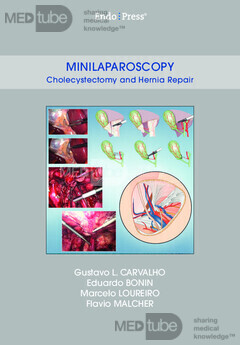
Minilaparoscopy - Cholecystectomy and Hernia Repair
Case description
Minimal access surgery is an improved surgical technique enabling surgeons to perform complex procedures causing less surgical trauma and consequently less pain, leading to a faster recovery.18 Other benefi ts are improved cosmetics from diminished or hidden marks of the surgical procedure. Minilaparoscopy (in the following termed as ‘Mini’) has emerged as a natural advancement of laparoscopy and was first presented in 1996 with a proposal to diminish surgical trauma by reducing the diameter of standard laparoscopic instruments. Using the minilaparoscopic cholecystectomy procedure as a model, the first instruments designed for that purpose, were not cost-effective because they involved the use of expensive, fragile miniature scopes and a lot of disposable items. This surgical instrument setup made mini unpopular and applicable to only a minority of laparoscopic surgeons. At this time, claimed advantages of this technique were less parietal damage, less pain, faster recovery, shorter hospitalization, early return to daily activities and even better cosmetic results when compared to laparoscopy. Ten years later, with the advent of Natural Orifice Translumenal Endoscopic Surgery (NOTES) and more recently, Single Incision Laparoscopic Surgery (SILS), reduced trauma and better cosmetic outcomes where accomplished by eliminating or reducingthe number of operative ports. Novel access sites (i.e. transvaginal) and novel instruments allowed transvisceral and transumbilical procedures utilizing only one port for inserting all surgical instruments, thus inaugurating the ‘reduced portal surgery era’. Although conceptually ideal for achieving a no-scar surgery, these techniques are currently mostly performed using at least one extra surgical (mini-)port that allows to maneuver laparoscopic instruments for organ retraction. As some of these techniques became feasible, there are still concerns regarding costs and safety for its widespread use. Meanwhile, and aside from this trend, minilaparosocopy have been used over the years around the world for performing a variety of surgical procedures in a safe and consistent fashion. Currently, minilaparoscopic cholecystectomy (MLC) is the procedure where the mini technique is most often used. Mini has also been used in a series of procedures, such as appendectomy, liver, kidney and mesenteric cysts, inguinal hernia repair, lumbar sympathectomy and refl ux disease, among others. Mini instruments have also been widely used in gynecology. For thoracic procedures, where it should be termed minithoracoscopy, mini enables thorax sympathectomy and biopsies for example. The employment of mini in pediatric surgery has been accepted with enthusiasm, a fact that is refl ected in many different procedures. Interestingly, with the advent of the reduced port surgery era, minilaparoscopy regained attention as an attractive option for improving cosmetics while preserving some valuable laparoscopic principles such as instrument triangulation. Despite its advantages, for some surgeons already performing minilaparoscopy for years, minilaparoscopic instruments could be improved for better performance at low cost, thus allowing minilaparosocopy to be an even more attractive technique.
